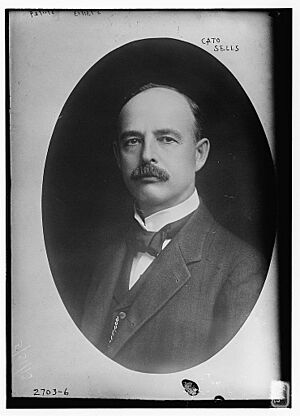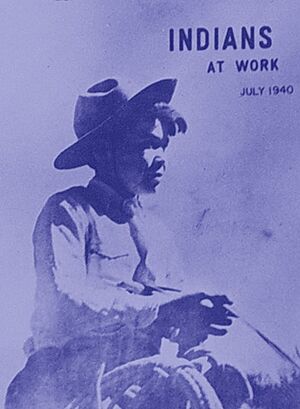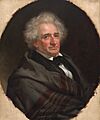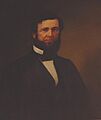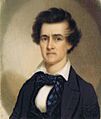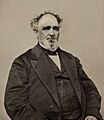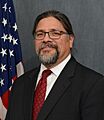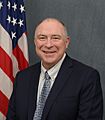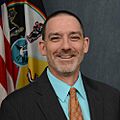Bureau of Indian Affairs facts for kids
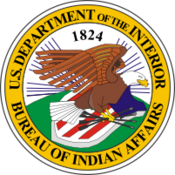
Seal
|
|

Flag
|
|
| Agency overview | |
|---|---|
| Formed | March 11, 1824 |
| Preceding agency |
|
| Jurisdiction | Federal Government of the United States |
| Headquarters | Main Interior Building 1849 C Street, NW Washington, DC 20240 |
| Employees | 4,569 (FY2020) |
| Annual budget | $2.159 billion (FY2021) |
| Agency executives |
|
| Parent agency | United States Department of the Interior |
| Child agencies |
|
The Bureau of Indian Affairs (BIA), also known as Indian Affairs (IA), is a United States government agency. It is part of the Department of the Interior. The BIA helps carry out federal laws and rules for Native Americans and Alaska Natives.
It also manages over 55.7 million acres (about 225,000 square kilometers) of reservations. These lands are held in trust by the U.S. government for indigenous tribes. The BIA provides services to about 2 million indigenous Americans from 574 federally recognized tribes. The agency is led by a director and overseen by the Assistant Secretary for Indian Affairs.
The BIA works with tribal governments. They help with law enforcement and justice, and support growth in farming, buildings, and the economy. They also help improve tribal governance and manage natural resources. Their main goal is to make life better in tribal communities. The Bureau of Indian Education handles school services. Health care for Native Americans is managed by the U.S. Department of Health and Human Services through its Indian Health Service.
The BIA is one of the oldest federal agencies in the U.S. It started in 1775 as the Committee on Indian Affairs. Benjamin Franklin was its first head. This committee managed trade and treaties with different indigenous groups. The Bureau of Indian Affairs was officially created in 1824 by Secretary of War John C. Calhoun. In 1849, it moved to the new Department of the Interior. Before 1947, it was known by names like the Indian Office or Indian Bureau.
For a long time, the BIA's main goal was to make Native Americans live like other Americans and to take over their land. But since the Indian Self-Determination and Education Assistance Act in 1975, the BIA has focused more on helping tribes make their own decisions. They now work more as partners with tribal governments.
Between 1824 and 1977, 42 people led the BIA as commissioners. Six of them were of indigenous descent. Since 1977, all thirteen Assistant Secretaries for Indian Affairs have been Indigenous. This includes Bryan Newland, who was appointed in 2021. Most BIA employees today are American Indian or Alaska Native. This is the highest number in the agency's history.
Contents
How the BIA is Organized
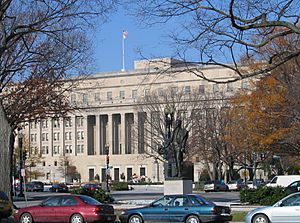
The BIA's main office is in the Main Interior Building in Washington, D.C.. It is led by a bureau director who reports to the Assistant Secretary for Indian Affairs. The current acting Assistant Secretary for Indian Affairs is Scott Davis.
The BIA helps 574 federally recognized tribes through four main offices:
- Office of Indian Services: This office handles general help, disaster relief, and support for Native American children and families. It also helps with tribal government and self-determination programs.
- Office of Justice Services (OJS): This office runs or funds law enforcement, tribal courts, and jails on federal Indian lands. OJS supports 208 law enforcement agencies. This includes 43 BIA-run police agencies and 165 tribal agencies. The OJS helps with criminal investigations, corrections, drug enforcement, and police training.
- Office of Trust Services: This office works with tribes and individual Native Americans and Alaska Natives. It helps them manage their trust lands, money, and natural resources.
- The Office of Field Operations: This office oversees 12 regional offices and 83 local agencies. These offices carry out the BIA's work directly with tribes.
A Look at BIA History

Early Beginnings: 1775-1822
The first groups dealing with Native Americans started in 1775. The Second Continental Congress created three agencies for Indian affairs. Benjamin Franklin and Patrick Henry were among the first leaders. Their job was to make treaties with Native Americans. This was to ensure they stayed neutral during the American Revolutionary War.
In 1789, the U.S. Congress put Native American relations under the new War Department. By 1806, Congress created the Superintendent of Indian Trade. This office was part of the War Department. It was in charge of the United States Government Fur Trade Factory System. Thomas L. McKenney held this position from 1816 until the system ended in 1822.
The Bureau of Indian Affairs is Formed: 1824-Present
When the trading system ended, there was a need for a new way to manage relations with Native Americans. The Bureau of Indian Affairs was created on March 11, 1824. Secretary of War John C. Calhoun started it as a part of his department. He did this without direct approval from Congress. McKenney was the first head of this new office. He called it the "Indian Office," but Calhoun preferred "Bureau of Indian Affairs."
At first, the Bureau was organized by region. Leaders called Superintendents of Indian Affairs were chosen for different parts of the U.S. They negotiated with tribes and oversaw local Indian agents. In 1878, the Bureau was reorganized. Regional offices replaced the superintendencies, and these regional offices still exist today.
The Removal Era: 1830-1850
During this time, the U.S. government moved many Native Nations westward. The Supreme Court case Cherokee Nation v. Georgia (1831) said that Native American nations were "domestic dependent nations." This meant they were not fully independent countries but had their own rights. This ruling was important for future treaties.
One major event was the removal of the Cherokee Nation from Georgia in 1838. This event is often called the Trail of Tears. In 1832, Congress created the job of Commissioner of Indian Affairs. In 1849, the Indian Affairs office moved to the new U.S. Department of the Interior. In 1869, Ely Samuel Parker became the first Native American to be Commissioner of Indian Affairs.
Assimilation Policies: 1890-1930
One of the most debated policies of the BIA was the effort to make Native American children live like other Americans. This happened through boarding schools, like the Carlisle Indian Industrial School. These schools took children away from their families and cultures. They taught students to follow Anglo-American customs. The idea was to help Native children fit into American society. However, these schools often stopped students from using their native languages and practicing their traditions.
Changes and Reorganization: Mid to Late 20th Century
The office was officially renamed from Office of Indian Affairs to Bureau of Indian Affairs in 1947.
In the 1960s and 1970s, Native American activism grew. Groups like the American Indian Movement (AIM) demanded that treaty rights be honored and that tribes have more control over their lives. This was a challenging time for the BIA.
Some important events involving the BIA during this period included:
- The occupation of BIA headquarters in Washington, D.C., in 1972: On November 3, 1972, a group of about 500 American Indians with AIM took over the BIA building. This was part of their "Trail of Broken Treaties" march. They wanted to bring attention to Native American issues. These issues included demands for new treaty talks, honoring treaty rights, and better living conditions. They stayed in the building for about a week, causing some damage. Many important records were lost or damaged.
- The Wounded Knee Incident of 1973, where activists occupied land on the Pine Ridge Indian Reservation for over two months.
Many Native Americans continue to have concerns about BIA policies. There have been ongoing issues with enforcing treaties and managing tribal lands and funds.
The 21st Century
In 2002, Congress worked with the BIA to create new rules for recognizing tribes. Another bill helped ensure tribes could take part in BIA decisions through grants. These bills clarified what services, limits, and responsibilities federally recognized tribes have.
In 2013, the BIA faced budget cuts. This especially affected the Indian Health Service, which was already underfunded.
BIA's Current Mission
The BIA is working to change its role. It wants to move from telling tribes what to do to advising them and working as a partner. This has been a difficult change. Many Native Americans remember the BIA as an agency that historically controlled tribes and their members, often based on treaties.
Leaders of the BIA
Over the years, many people have led the Bureau of Indian Affairs. Here are some of the key positions and the people who held them.
Superintendents of Indian Trade (1806-1822)
This position managed trade and relations with Native American tribes.
| Image | Superintendent | Term started | Term ended |
|---|---|---|---|
| John Shee | July 8, 1806 | October 3, 1807 | |
 |
John Mason | October 4, 1807 | April 1, 1816 |
 |
Thomas L. McKenney | April 12, 1816 | May 6, 1822 |
Superintendent of Indian Affairs (1822-1838)
This role was created after the trading houses were closed.
| Image | Superintendent | Term started | Term ended | Notes |
|---|---|---|---|---|
 |
William Clark | May 28, 1822 | September 1, 1838 | His position became part of the new Indian Office in 1824. |
Chief Clerks of the Indian Office (1824-1832)
These individuals led the Indian Office within the War Department.
| Image | Chief Clerk | Term started | Term ended |
|---|---|---|---|
 |
Thomas L. McKenney | March 12, 1824 | August 16, 1830 |
| Samuel S. Hamilton | September 30, 1830 | August 31, 1831 | |
| Elbert Herring | August 12, 1831 | July 9, 1832 |
Commissioners of Indian Affairs (1832-1981)
This was the main leadership role for the Bureau of Indian Affairs for many years.
| Image | Commissioner | Term started | Term ended |
|---|---|---|---|
| Elbert Herring | July 10, 1832 | July 2, 1836 | |
 |
Ely S. Parker | April 26, 1869 | July 24, 1871 |
 |
Cato Sells | June 2, 1913 | March 29, 1921 |
 |
John Collier | April 21, 1933 | January 22, 1945 |
 |
Benjamin Reifel | December 7, 1976 | January 28, 1977 |
Assistant Secretaries of the Interior for Indian Affairs (1977-Present)
This position was created in 1977 and is the highest leadership role for Indian Affairs.
| Image | Assistant Secretary | Term started | Term ended | Affiliation |
|---|---|---|---|---|
| Forrest Gerard | September 12, 1977 | January 19, 1980 | Blackfeet | |
 |
Tara Sweeney | July 9, 2018 | January 20, 2021 | Inupiat |
 |
Bryan Newland | September 8, 2021 | January 20, 2025 | Ojibwe |
 |
Bryan Mercier | January 20, 2025 | March 18, 2025 | Grand Ronde |
| Scott Davis | March 18, 2025 | present | Standing Rock Sioux |
Bureau Directors (2003-Present)
Bureau directors assist the Assistant Secretary for Indian Affairs.
| Image | BIA Director | Term started | Term ended | Affiliation |
|---|---|---|---|---|
| Terry Virden | July 1, 2002 | 2004 | White Earth Chippewa | |
 |
Bryan Mercier | September 30, 2024 | Present | Grand Ronde |
Images for kids
See also
 In Spanish: Oficina de Asuntos Indígenas para niños
In Spanish: Oficina de Asuntos Indígenas para niños
- Title 25 of the Code of Federal Regulations
- Aboriginal Affairs and Northern Development Canada
- Administration for Native Americans
- American Indian Movement
- British Indian Department, during American Revolution
- Bureau of Indian Affairs Police
- Confederate States Bureau of Indian Affairs
- Commission of Indian Affairs, state equivalents of the federal Bureau
- Indian agent
- Indian Claims Commission
- Indian reservations
- National Indian Gaming Commission
- Outline of United States federal Indian law and policy


